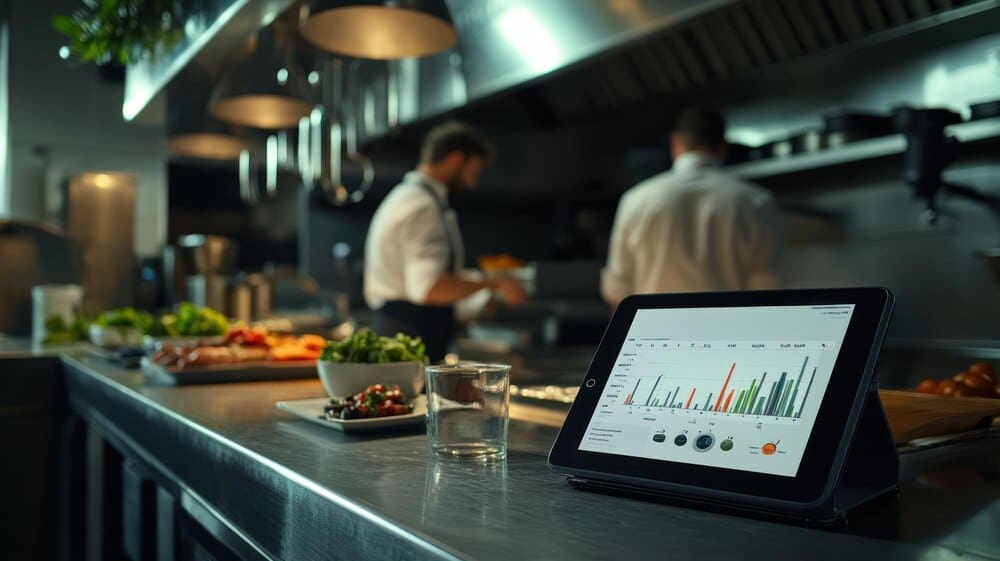KEY POINTS
- The restaurant industry is using AI to revolutionize menu engineering by moving beyond static, historical data to a dynamic, multi-dimensional analysis that optimizes item placement, pricing, and ingredient selection.
- AI systems supercharge menu engineering by aggregating diverse data—including sales, inventory, weather, and social media trends—to predict demand with high accuracy, which boosts profitability and drastically reduces food waste.
- The next frontier is hyper-personalization, where AI creates dynamic menus for individual customers based on their ordering history and preferences, which fosters loyalty and increases average check sizes.
Restaurants and food service businesses are increasingly turning to artificial intelligence to revolutionize one of their most fundamental assets: the menu. By leveraging AI for sophisticated menu engineering and hyper-personalization, operators are moving beyond traditional quarterly analyses to a new era of dynamic, data-driven decision-making. This technological shift allows businesses, from global fast-food chains to independent cafes, to analyze vast datasets in real time, optimizing item placement, pricing, and even ingredient selection to boost profitability, reduce waste, and build powerful customer loyalty in an intensely competitive market.
The Evolution from Classic to AI-Powered Menu Engineering
For decades, menu engineering has been a cornerstone of restaurant management. The classic approach, developed in the 1980s, involves a relatively straightforward analysis that categorizes every menu item into one of four quadrants based on its popularity (number sold) and profitability (contribution margin).
These categories are famously known as Stars (high popularity, high profitability), Plowhorses (high popularity, low profitability), Puzzles (low popularity, high profitability), and Dogs (low popularity, low profitability). The strategy was simple: promote Stars, re-price Plowhorses, re-think Puzzles, and remove Dogs. This method, while effective, relies on historical point-of-sale (POS) data and often remains static for months at a time.
Artificial intelligence completely transforms this model. Instead of a static, two-dimensional matrix, AI introduces a dynamic, multi-dimensional analysis that incorporates a far richer tapestry of data. It moves the process from a reactive review to a proactive, predictive strategy.
Supercharging the Data Analysis
An AI system doesn’t just look at sales and margin. It ingests and correlates information from a multitude of sources simultaneously. This includes POS data, but also inventory systems tracking real-time ingredient costs, supply chain disruptions, and potential spoilage.
Furthermore, AI can integrate external data streams that were previously impossible to factor into menu decisions. It can analyze weather patterns to predict a surge in demand for hot soup on a cold day, or iced coffee during a heatwave. It can scan local event calendars and adjust for increased foot traffic, or even monitor social media trends to identify emerging flavor profiles and dietary preferences.
How AI Systems Engineer a Smarter Menu
The power of AI in this context lies in its ability to run complex machine learning algorithms that identify patterns and make recommendations far beyond human capacity. The process typically involves several key components working in concert.
Data Aggregation and Processing
The foundation of any AI menu tool is its ability to pull in diverse data. A robust system will connect directly to a restaurant’s core operational software, including its POS and inventory management systems. It also scrapes data from customer-facing platforms like loyalty apps, online ordering websites, and even third-party delivery services.
Crucially, it uses Natural Language Processing (NLP) to understand unstructured text data. The AI can read thousands of online customer reviews from sites like Yelp or Google, deciphering sentiment around specific dishes. It can tell you not just that the “Spicy Chicken Sandwich” is a bestseller, but that 15% of recent reviews mention it’s too spicy, a critical insight for recipe refinement.
Predictive Analytics and Forecasting
Once the data is aggregated, predictive models get to work. These algorithms forecast future demand for each menu item with remarkable accuracy. This helps kitchens optimize their prep work and ingredient purchasing, directly reducing one of the industry’s biggest problems: food waste.
This forecasting isn’t just about volume; it’s about timing. The AI can predict that a lunch rush will be heavier on salads and sandwiches, while dinner service will see more demand for steaks and pasta entrees. This allows for smarter staff allocation and kitchen workflow throughout the day.
Actionable Recommendations
The final output isn’t a raw data file; it’s a set of clear, actionable insights. The AI might suggest a dynamic pricing strategy, recommending a slight price increase on a high-demand delivery item during peak hours. It can propose “smart pairings,” suggesting servers upsell a specific glass of wine that pairs well with a high-margin “Puzzle” dish to improve its popularity.
AI can even influence the physical or digital layout of the menu itself. By understanding how customers’ eyes track across a page or screen, the system can recommend placing your “Star” items in the most prominent positions, a concept known as menu psychology, but now backed by immense data.
The Next Frontier: Hyper-Personalization at Scale
While optimizing the master menu is a significant leap forward, the true game-changer is using AI to personalize the menu for each individual customer. This moves the experience from transactional to relational, fostering a level of loyalty that generic marketing cannot achieve.
This is made possible by the data collected through loyalty programs, mobile apps, and online ordering profiles. An AI system can build a unique taste profile for every customer who opts in, tracking their order history, dietary preferences, spice tolerance, and even the time of day they typically order.
Dynamic Menus in Action
Imagine a customer opening a restaurant’s mobile app. Instead of seeing the same static menu as everyone else, the AI curates the display just for them. If the customer is a known vegan, the new plant-based burger is the first thing they see. If they frequently order gluten-free items, those options are automatically highlighted.
This personalization extends to suggestions and upsells. The system knows a customer always orders an Americano. When they add it to their cart, the AI can prompt them with a personalized offer: “We know you love our Americano. Customers like you also enjoy our new Almond Croissant. Add one for 50% off?” This targeted approach has a much higher conversion rate than a generic pop-up.
In-store kiosks at quick-service restaurants (QSRs) are another key venue for this technology. When a customer scans their loyalty card, the entire menu board can instantly re-sort to feature their favorites and suggest new items based on their past behavior, reducing decision time and increasing average check size.
The Tangible Business Benefits
The adoption of AI for menu management isn’t a merely futuristic concept; it delivers concrete returns on investment across the business.
Driving Revenue and Profitability
By strategically promoting high-margin items, implementing dynamic pricing, and executing highly effective upsells, restaurants can see a direct lift in revenue. Optimizing ingredient purchasing based on accurate demand forecasts also protects and expands profit margins by cutting down on waste and spoilage costs.
Enhancing Customer Experience and Loyalty
Personalization makes customers feel seen and understood. It removes friction from the ordering process and introduces them to new items they are statistically likely to enjoy. This positive experience builds brand affinity and transforms occasional visitors into loyal regulars, increasing their lifetime value to the business.
Improving Operational Efficiency
Accurate forecasting allows for smarter inventory management, preventing both stock-outs of popular ingredients and over-ordering of slow-moving ones. This creates a more efficient, sustainable, and resilient supply chain. Kitchens can run more smoothly, with prep lists and staffing schedules that are aligned with AI-predicted demand.
Implementation Challenges and Ethical Guardrails
Despite the immense potential, deploying an AI menu system is not without its challenges. The primary concern for any business is the cost and complexity of implementation. It requires integrating disparate technology systems and often necessitates hiring or training staff with data science skills.
More importantly, businesses must navigate the ethical considerations of using customer data. Transparency is paramount. Customers must be clearly informed about what data is being collected and how it is being used to personalize their experience. Adherence to data privacy regulations like GDPR is not just a legal requirement but a matter of customer trust.
Finally, there is a fine line between helpful personalization and intrusive surveillance. Restaurants must be careful not to create a “creepy” experience. The goal is to enhance the human element of hospitality, not replace it. The AI should be a tool that empowers staff to provide better service, not a system that makes the customer feel like a data point.
A New Recipe for Success
AI-powered menu engineering and personalization represent a seismic shift in how the food service industry operates. It elevates the menu from a simple list of offerings to a dynamic, intelligent tool for driving growth and efficiency. By harnessing the power of data, restaurants can make smarter decisions about pricing, promotion, and product development while simultaneously creating more engaging and satisfying experiences for their customers.
While the technology provides the blueprint, the art of culinary creation and the warmth of genuine hospitality remain the soul of the industry. The businesses that will thrive in the coming decade are those that successfully blend these timeless ingredients with the powerful, data-driven insights that only artificial intelligence can provide.








